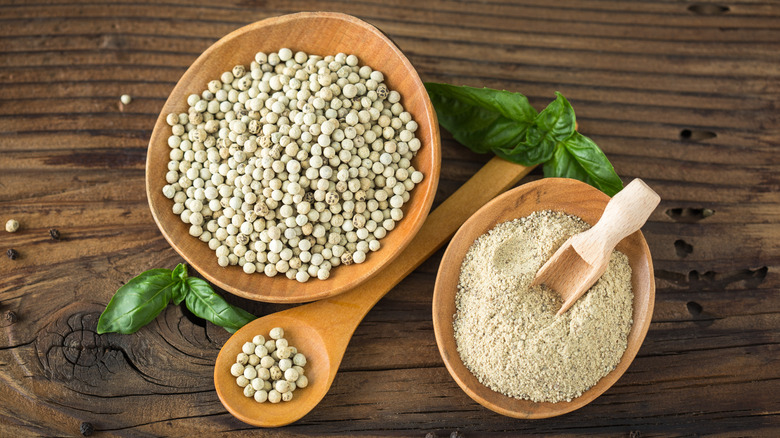The Safety Precaution You Should Always Take With White Pepper
Whether you have a specific dish in mind, such as using harissa powder for a North African tagine, or you just need spices for a general purpose, like sprinkling salt and black pepper over fresh tomatoes — seasoning matters. Interestingly, there's another kind of pepper called white pepper, and it comes from the same plant as black pepper. Black peppercorns aren't fully ripe when they're harvested, whereas white peppercorns are the same berries, fully ripened. Also, because of the way that white peppercorns are processed, their flavor isn't as strong as black peppercorns.
White pepper's flavor is commonly labeled as mild, grassy, and fermented, with slight ginger notes. Most often, white pepper is used in Vietnamese, Chinese, and other Asian dishes, such as hot and sour soup. White pepper can also be found in some European dishes, like Swedish meatballs. Sometimes, white pepper may be used just for looks, such as in mashed potatoes or a white cream sauce to avoid the speckles black pepper can leave behind. However, when using white pepper, safety precautions should be taken.
White pepper has a dangerously fine texture
The main safety issue with white pepper in its ground form is, oftentimes, the spice particles may find their way into your throat and/or eyes due to the texture. So, before you sprinkle white pepper into a pan — or onto anything else — take a step back!
In the United States, Mesh Size is a way to measure particles to see how large or small they are — with larger numbers representing smaller particle sizes. Whole peppercorns have a mesh size of six, while cracked peppercorns can measure anywhere from an eight to a 10. Peppercorns that have been more coarsely ground have a Mesh Size of 12 to 14. Ground pepper that's typically served on dining tables is between 18 and 28 Mesh, and more finely ground pepper can have a Mesh Size of 30 to 60.
Experts recommend purchasing whole white peppercorns, or any spice for that matter, and grinding them as needed. Spices tend to not be as effective if they sit around for a while after being ground. Because white pepper and black pepper have totally different flavor profiles and colors, it's also not suggested to swap them for each other unless a recipe calls for only a small amount of pepper and isn't specific.

